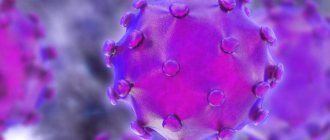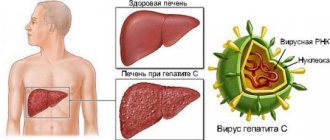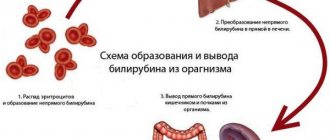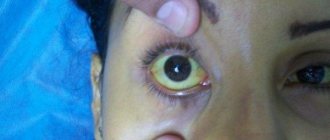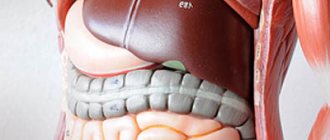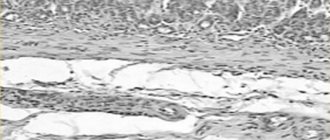One of the main functions of the liver is to remove and break down most chemicals from the blood. The processing and breakdown of toxins creates byproducts that can cause liver damage. And although the liver has great potential for regeneration, constant exposure to toxic substances can lead to serious illnesses and cause irreparable damage to health.
Toxic hepatitis is characterized by liver damage due to exposure to any toxic substance and is manifested by unpleasant, painful sensations in the area of the right hypochondrium, yellowing of the sclera of the eyes and skin, and general weakness.
Typically, toxic hepatitis develops within hours or days after exposure to the toxin. However, in some cases, toxic hepatitis can take a long time to develop, with several months passing before signs and symptoms of toxic hepatitis appear.
Symptoms of toxic hepatitis often go away when the body's exposure to the toxin stops. However, this does not mean that the patient should lose vigilance. Toxic hepatitis can cause liver damage, which in turn leads to permanent scarring of the liver tissue (cirrhosis) and, in some cases, liver failure. Therefore, any manifestations and symptoms of toxic hepatitis should be carefully examined by a doctor, and based on the results of the research, the patient should undergo a course of treatment.
Risk factors
Factors that may increase the risk of toxic hepatitis include:
- in the incorrect or inappropriate use of painkillers and other medications: by taking medications that are not prescribed by your doctor, you must understand that you can cause harm to your health: the risk of liver damage and the risk of toxic hepatitis increases significantly. This is especially true if you are using multiple medications or taking more than the recommended dose
- in existing liver diseases: Having serious liver disorders such as cirrhosis or fatty liver disease makes you much more susceptible to the effects of toxins
- in existing hepatitis: people diagnosed with hepatitis B or C are much more likely to develop toxic hepatitis
- in aging: As you age, your liver breaks down harmful substances more slowly. This means that toxins and their products can remain in your body much longer
- Alcohol use: Alcohol is known to increase the toxic effects of most medications and is also a potent liver toxin in itself.
In addition, women are much more susceptible to toxic hepatitis. Women have a slower metabolism than men, so their liver is exposed to higher concentrations of harmful substances over a longer period of time. This increases the risk of developing toxic hepatitis.
Some genetic diseases can also contribute to the development of this unpleasant disease. Inheriting certain genetic mutations that affect the production of liver enzymes that break down toxins can make you more susceptible to toxic hepatitis.
Working with industrial toxins is a powerful test for the body and can also provoke toxic hepatitis.
Literature:
- M.A. Livzan, Doctor of Medical Sciences, Professor, E.A. Lyalukova, Ph.D. Alcoholic liver disease: modern aspects of diagnosis and treatment. Omsk State Medical Academy of the Ministry of Health of Russia, 2014.
- E.Yu. Eremina. Alcoholic liver disease. Parts 1, 2. Federal State Budgetary Educational Institution of Higher Professional Education Mordovian State University named after. N.P. Ogareva, Department of Propaedeutics of Internal Diseases, 2012
- Diseases of the liver and biliary tract. Ed. V.T. Ivashkina. Guide for doctors, 2nd ed., rev. and additional M.: Publishing house. House M-Vesti, 2005. 536 p.
- Moiseev V.S. Alcoholic liver disease. Clinical hepatology, 2006. No. 1. pp. 3-8.
- A.A. Antonyan, E.I. Kashkina, R.V. Lyakisheva. Modern ideas about alcoholic liver disease. Saratov Medical Scientific Journal, 2010, volume 6, No. 2, p. 317-322.
Signs and symptoms
The main symptoms of toxic hepatitis are discomfort in the right hypochondrium, nausea, bitterness in the mouth, bloating, itchy skin. On palpation, the unpleasant sensations become sharp and painful.
There are two forms of toxic hepatitis. The acute form is expressed by increased body temperature, weakness, pain in the right side, joints, yellowness of the skin and mucous membranes. Another form of the disease is latent (little clinically manifested). The disease usually manifests itself in increased fatigue, irritability, low-grade fever, and lack of appetite. Liver enlargement can only be felt by palpation.
Causes
Toxic hepatitis, or acute toxic inflammation of the liver, can be caused by medications, narcotic drugs, alcohol and its surrogates. Toxic substances can enter the body with air containing impurities of chemicals, poisons, and solvents. Possible liver damage due to acute food poisoning.
Drug-induced damage can be caused by thousands of different medications available to the general consumer. The risk group includes antihistamines and antibiotics, antipyretic, antirheumatic, hormonal drugs, antidepressants, neuro- and psychotropic substances, and many antidiabetic drugs. Toxic liver damage can be caused by either an overdose of a drug or long-term use of one or more drugs.
Alcohol can cause toxic hepatitis, both with a one-time excessive libation, and with the systematic use of various types of alcoholic beverages.
In recent years, cases of toxic hepatitis due to drug use have become more frequent.
Among food products, the most common provocateur of toxic liver damage is mushrooms.
Hepatitis is an inflammation of the liver. If the inflammatory process lasts less than 6 months, hepatitis is acute; if it lasts more than 6 months, it is chronic.
Hepatitis can be caused by various factors. There are infectious and non-infectious hepatitis. Among infectious diseases, the most common are viral ones, but there are hepatitis caused by bacteria and parasites. Non-infectious ones can be caused by toxic substances, including alcohol, diseases of other organs and systems of the body. Chronic alcoholism is one of the main causes of non-infectious hepatitis: approximately 20% of patients suffering from alcoholism for 5-6 years develop alcoholic liver damage.
As a rule, acute hepatitis ends in complete recovery. Sometimes the disease becomes chronic, which can last for months or years, and in some cases leads to cirrhosis or liver cancer.
Synonyms Russian
Non-infectious hepatitis, alcoholic hepatitis, non-alcoholic steatohepatitis, fatty hepatosis, drug-induced hepatitis, toxic hepatitis, toxic-allergic hepatitis, idiopathic hepatitis, autoimmune hepatitis, reactive hepatitis, chronic persistent hepatitis, chronic active hepatitis, necrotizing hepatitis, lobular hepatitis, neonatal hepatitis, acute hepatitis, chronic hepatitis.
English synonyms
Acutehepatitis, chronichepatitis, nonviral hepatitis, noninfectious hepatitis, non-alcoholic hepatitis, non-alcoholic steatohepatitis, NASH, toxic hepatitis, autoimmune hepatitis, neonatal hepatitis, d-induced hepatitis, alcoholic hepatitis.
Symptoms
In the initial stages, hepatitis may occur unnoticed. The first signs of the disease are usually nonspecific. The intensity of symptoms depends on the cause of hepatitis, the activity and duration of the pathological process. The main symptoms of hepatitis are:
- weakness, malaise;
- yellowness of the skin, sclera;
- pain in muscles and joints;
- loss of appetite;
- nausea, vomiting, heaviness in the stomach;
- fever.
General information about the disease
The liver is one of the most important human organs. It is located in the upper right part of the abdominal cavity, bordered by the diaphragm, right kidney, intestinal loops, stomach and consists of two main lobes (right and left), which are formed by thousands of lobules. The lobules consist of hepatocytes - cells responsible for performing the main functions of the liver. The liver is supplied by the hepatic artery, which carries oxygen-rich blood, and the portal vein, which carries blood from the gastrointestinal tract. The outflow of blood is carried out through the hepatic vein. There is also a complex system of bile ducts through which the synthesized bile enters the gallbladder, where it accumulates, and into the intestines.
The liver performs a number of vital functions: synthesizes proteins (albumin, coagulation factors), cholesterol, enzymes, hormones, bile, cleanses the blood of excess hormones, metabolic products, toxins and microorganisms that enter the blood through the digestive system, participates in the metabolism of carbohydrates, vitamins, microelements.
Exposure to a number of factors can lead to liver damage and disruption of its function. With hepatitis, the liver tissue becomes inflamed, leukocytes accumulate in it, areas of necrosis (death) may appear, and a small amount of connective fibrous tissue appears. However, in general, unlike cirrhosis, the structure of the liver lobules is not disturbed. Inflammation is accompanied by stagnation of bile and dysfunction of hepatocytes.
Depending on the cause of occurrence, the following types of non-infectious hepatitis are distinguished.
- Alcoholic hepatitis. It is formed as a result of many years of alcohol abuse, which disrupts the metabolism in hepatocytes, leading to their destruction.
- Non-alcoholic steatohepatitis. This is a condition in which changes in the liver resemble alcoholic hepatitis, but are not associated with alcohol intake. Non-alcoholic steatohepatitis can be combined with metabolic diseases: obesity, diabetes. In some cases, it occurs in people without concomitant diseases and even in children.
- Drug-induced hepatitis. Taking a number of medications - antibiotics, anti-tuberculosis drugs, oral contraceptives - sometimes leads to hepatitis. The likelihood of toxic effects of drugs on the liver is determined by individual tolerance to the drugs.
- Toxic hepatitis. It can be caused by poisonous mushrooms, alcohol substitutes, arsenic compounds, toluene, benzene, lead and other substances that have a direct destructive effect on liver cells.
- Autoimmune hepatitis. With this disease, the immune system is disrupted, which begins to destroy its own, normal liver cells. The mechanism of development of autoimmune hepatitis is not fully understood.
- Metabolic hepatitis. Caused by hereditary metabolic diseases, such as hemochromatosis (increased absorption of iron in the intestine with its deposition in the tissues of the body) or Wilson's disease (a disorder of copper metabolism with its deposition in the liver and other organs).
- Reactive hepatitis. It can be formed as a result of exposure to toxins and metabolic products that enter the blood during diseases of other organs (stomach ulcers, pancreatitis, endocrine and autoimmune diseases).
- Primary biliary hepatitis. Associated with impaired patency of the bile ducts, impaired outflow of bile, which leads to damage to liver tissue.
Liver cells in hepatitis can be damaged not only as a result of direct exposure to toxic substances, but also due to the pathological activity of cells of the body's own immune system. As a result, the functioning of the liver is disrupted, which leads to the characteristic symptoms of hepatitis: the liver increases in size, there is a feeling of heaviness in the abdomen, the outflow of bile necessary for the digestion of fats slows down, which causes nausea, vomiting, flatulence, stool disorders (diarrhea or constipation ). Violation of protein (albumin) synthesis leads to a decrease in the osmotic pressure of the blood and the release of fluid into the tissue, which causes edema. A decrease in the number of clotting factors leads to increased bleeding. The purification of the blood from toxic substances is impaired, which is manifested by weakness, malaise, and fever. Yellowness of the skin and mucous membranes is caused by an increase in bilirubin levels. It is formed during the destruction of red blood cells, binds to glucuronic acid in the liver (direct, bound bilirubin is formed) and is excreted in the bile. With hepatitis, this process is disrupted and direct bilirubin enters the blood.
Who is at risk?
- Alcohol abusers.
- Obese people.
- Patients with chronic autoimmune and endocrine diseases.
- Patients who require long-term use of medications that have a toxic effect on the liver.
- Contact with high doses of toxic chemicals.
Diagnostics
Manifestations of hepatitis depend on the immediate cause of liver damage. In some cases, hepatitis may have nonspecific symptoms or even be asymptomatic. A thorough interview and examination of the patient helps the doctor suspect hepatitis, but additional research is needed to make a final diagnosis.
Laboratory diagnostics
- General blood analysis. An increased level of white blood cells is a sign of the infectious nature of hepatitis.
- Prothrombin index. This is the ratio of the blood clotting time of a healthy person to the clotting time of a sick person. Prothrombin is a precursor of thrombin and is involved in blood clotting. The test is used to evaluate the rate of blood clotting. In the initial stages of hepatitis, the prothrombin index is normal; in severe cases of the disease it can be reduced.
- Fibrinogen. A blood clotting factor that is synthesized by liver cells. When liver tissue is damaged, fibrinogen is reduced.
- AST (aspartate aminotransferase), ALT (alanine aminotransferase). Liver enzymes that enter the bloodstream when liver tissue is damaged. With hepatitis, they may be increased.
- Gamma-glutamyl transpeptidase (gamma-GT). A liver enzyme, the amount of which increases with damage to the liver and bile ducts.
- Alkaline phosphatase. An enzyme that is found in all tissues of the body, but in the greatest quantities in bones, kidneys and liver. In case of hepatitis, it may be increased.
- Total bilirubin. Bilirubin in hepatitis is increased mainly due to the direct (bound) fraction.
- Total whey protein. With hepatitis, the level of total protein can be reduced by reducing the amount of albumin.
- Total cholesterol. This substance is synthesized in the liver and is an element of cell membranes, a precursor of bile acids and some hormones. In case of hepatitis, it may be lowered, which indicates a violation of the synthetic function of the liver.
- Tests for hepatitis B, C, D. The presence of hepatitis viruses in the body is determined as a possible cause of the disease.
- Ferritin, transferrin. Ferritin is a protein that binds iron in the liver, and transferrin is a protein that transports iron from the intestines to the liver. Their levels may be elevated in hemochromatosis.
- Copper, ceruloplasmin. The level of these substances is measured when Wilson's disease is suspected, in which the concentration of ceruloplasmin decreases and the concentration of copper increases.
- Screening study for the presence of narcotic, psychotropic and potent substances. Determination of compounds that could cause hepatitis.
Additional Research
- Ultrasound of the abdominal organs. Used to determine the size and structure of the liver. With hepatitis, the liver may be enlarged.
- X-ray, CT, MRI. Helps determine the size and structure of the liver, and exclude other liver diseases.
- Retrograde cholangiography. This is an x-ray examination, which is carried out after the injection of a contrast agent into the bile ducts, visible in the image. Used to assess the patency of the bile ducts.
- Liver biopsy. Taking a sample of liver tissue using a thin, hollow needle that is inserted through the skin of the abdominal wall after preliminary anesthesia. It is carried out under ultrasound control. Microscopy of the sample taken reveals inflammation of the liver tissue, accumulation of leukocytes, and a small amount of connective tissue while maintaining the structure of the liver lobules.
Treatment
Treatment of acute hepatitis is based, first of all, on stopping the impact of the pathological factor on the liver and is aimed at preventing the disease from becoming chronic. Most acute hepatitis is completely curable. Chronic hepatitis, depending on the cause and activity of the process, can last from 6 months to several years. A long course involves regular examinations, strict adherence to the doctor’s recommendations, changes in the patient’s lifestyle - this is necessary for the prevention of liver cirrhosis, liver failure, and liver cancer.
Prevention
- Quitting alcohol and drugs.
- Follow the instructions and recommendations of the doctor when taking medications.
- Use of protective equipment when working with toxic chemicals.
- Fighting excess weight.
Recommended tests
- General blood analysis
- Coagulogram No. 2 (prothrombin (according to Quick), INR, fibrinogen)
- Alanine aminotransferase (ALT)
- Aspartate aminotransferase (AST)
- Gamma-glutamyl transpeptidase (gamma-GT)
- Total alkaline phosphatase
- Total bilirubin
- Direct bilirubin
- Total protein in whey
- Serum albumin
- Total cholesterol
- Transferrin
- Ferritin
- Ceruloplasmin
- Copper in the blood
- HBsAg, hypersensitive
- Anti-HCV, antibodies
- Screening study for the presence of narcotic, psychotropic and potent substances
- Cytological examination of punctates, scrapings of other organs and tissues
Diagnostics
Unfortunately, it is very difficult to distinguish toxic hepatitis from other liver diseases based on clinical manifestations. Mandatory and necessary tests for diagnosis are: biochemical blood test, coagulogram, general blood test and general urinalysis. The second necessary condition for diagnosis is to conduct a detailed and serious study of the medical history (history of the disease) in order to establish the factors that led to dysfunction of this vital organ.
For the described symptoms, consultation with a specialist – a hepatologist – is recommended. The doctor will select and prescribe the necessary laboratory and instrumental examinations.
To clarify the diagnosis, ultrasound diagnostics with the additional function of elastography, computed tomography and magnetic resonance imaging, and liver scintigraphy are available today to help the doctor. If necessary, to identify or clarify the source of poisoning, a puncture or larascopic marginal biopsy is prescribed.
Content:
- Etiology.
- Pathogenetic mechanisms of liver intoxication.
- Clinical picture of alcoholic liver intoxication: 3.1. Steatosis. 3.2. Alcoholic hepatitis. 3.3. Cirrhosis.
- Diagnostics.
- Principles of treatment: 5.1. Nutrition correction. 5.2. Drug treatment.
Alcoholic liver intoxication refers to the sequential development or combination of several diseases: steatosis (fatty degeneration), hepatitis and cirrhosis. In this case, the pathology can be asymptomatic (or with a “blurred”, non-specific clinical picture) until the development of irreversible changes. According to WHO, alcoholic liver poisoning is the most common disease in hepatology.
Treatment
To treat toxic hepatitis, it is necessary, first of all, to exclude further intake of the poison that caused poisoning of the body and inflammation of the liver tissue.
The patient is recommended to rest in bed, and in some cases, hospitalization. Drugs are prescribed that help remove toxins from the body; drugs that protect and restore liver cells - hepatoprotectors - are recommended.
In case of severe liver damage, intravenous detoxification and hepatoprotective therapy is carried out, as well as procedures that allow the removal of a toxic substance and its metabolic products from the body - methods of extracorporeal hemocorrection (plasmapheresis, etc.)
It should be remembered that the liver is the main filter of the body. And the malfunction of this filter can quickly manifest itself as a dysfunction of many other organs.
To draw up an effective plan for the treatment of toxic hepatitis, it is necessary to contact a specialist who can take into account the peculiarities of the interaction of prescribed medications with each other, as well as the characteristics of the body of the affected patient.
Pathogenetic mechanisms of liver intoxication
The main metabolite of ethyl alcohol, acetaldehyde itself has a damaging effect on hepatocytes. This connection calls:
- damage to cell membranes and, accordingly, their necrosis;
- increased synthesis of triglycerides and their deposition in hepatocytes;
- impaired synthesis of serum albumin (this protein determines the colloid osmotic pressure of the blood);
- violation of the filtration function of the liver;
- stimulation of lipid peroxidation processes.
In place of damaged hepatocytes, foci of connective tissue form. This leads to a deterioration in the blood supply to liver cells, progression of the inflammatory reaction, and activation of carcinogenesis processes. It has been established that one of the most dangerous forms of cancer, hepatocellular carcinoma, in the vast majority of cases develops against the background of progressive cirrhosis.
Prevention
No one knows in advance how the body will react to a particular drug. Therefore, toxic hepatitis cannot always be prevented. But you can reduce your risk of developing liver problems and avoid treatment for toxic hepatitis if:
- Take medications only as directed. Use medications only when absolutely necessary. Follow the instructions and do not exceed the recommended dosage, even if your condition does not improve.
- Be careful with herbs and supplements. Do not assume that this is a natural product that will not cause harm. Discuss the benefits and risks with your doctor before taking herbs and supplements.
- Do not mix alcohol and medications. Alcohol and drugs are a bad combination. Ask your doctor or pharmacist about interactions between alcohol and prescription and over-the-counter drugs you use.
- Take precautions when working with chemicals. If you use hazardous chemicals in your daily life, take all necessary precautions to protect yourself from exposure. If you come into contact with hazardous substances at work, follow the instructions at your workplace.
- Keep medications and chemicals out of the reach of children.
Disease prognosis
If the diagnosis of toxic hepatitis is made in a timely manner and the treatment is chosen correctly, the prognosis will be favorable. The liver can regenerate and restore a large proportion of dead cells. To aid recovery, it is necessary to treat concomitant diseases and eliminate the occurrence of complications.
An unfavorable outcome is possible if too much poison enters the body and assistance is not provided in a timely manner. In this case, life can only be saved with a liver transplant. Chronic toxic hepatitis often leads to cirrhosis, for example, when a person continues to consume alcohol, which does not allow cells to recover.

